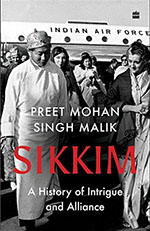Sikkim, a tiny Indian State with a population of less than a million, merged with India and became the 22nd State of the Indian Union in 1975. Ambassador Preet Mohan Singh Malik’s book, Sikkim: A History of Intrigue and Alliance, comes at a time when India’s strategic affairs are much debated notably after the Doklam, and Galwan Valley skirmishes. The book is rich in literature on strategic affairs that fused history, political and socio-cultural aspects of Sikkim which the author personally experienced as he served as an Indian Foreign Service Officer at the Indian Political Office in Sikkim from 1967-1970.
In reading Sikkim’s history, one cannot escape the cultural aspects of Lamaist Buddhism and the Namgyal Dynasty. Taking this into account, the book is divided into three sections. The first section deals with Britain, Tibet and Sikkim; the second concerns Britain’s perfidious dealings with Tibet; the last section deals with India, Tibet and Sikkim. The book successfully highlights the layers of historical trajectories and geographical importance of the Eastern Himalayas, Sikkim in particular, that are crucial to understand contemporary India-China relations.

